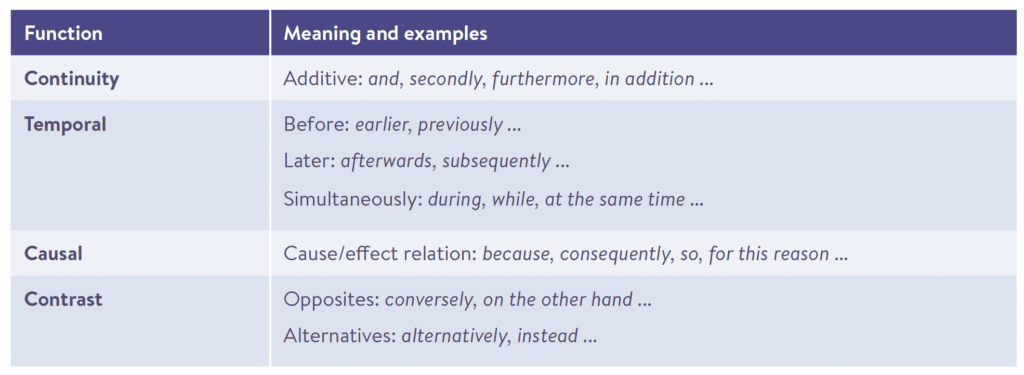Cohesive ties
Home » Comprehension » Cohesive ties
Cohesive ties include ‘anaphors’, which connect sentences without the use of repetition. Anaphors include pronouns and ellipses.
For example, instead of writing ‘Zoe and Lyla were great playmates. Zoe and Lyla played together every day’, an author might write, ‘Zoe and Lyla were great playmates. They played together every day’. In this example, the word ‘they’ connects the second sentence to the first by using the pronoun ‘they’ instead of repeating ‘Zoe and Lyla’.
Similarly, instead of writing, ‘Andrew enjoys cycling to work. Ben enjoys cycling to work, too’, an author might write, ‘Andrew enjoys cycling to work. Ben does, too.’ The word ‘does’ is an ellipsis that connects the sentences by replacing ‘enjoys cycling to work’ with ‘does’.
Another type of cohesive tie is a ‘connective’. These words convey how sentences are connected, in order (temporal), in causality, or in agreement (continuity) or disagreement (contrast). The table below lists some connectives and their functions. There is a typical pattern of acquisition: connectives that express continuity and additive relations appear first, followed by temporal connectives, then causal, and finally contrastive connectives. However, consistently appropriate use of connectives continues to develop for several years after they first appear in children’s speech. Development of understanding of connectives develops over a long period of time, with adult levels of mastery not always emerging by the end of primary school.
Readers need to understand how these cohesive ties work in order to make sense of the second sentence. Furthermore, these connectives are not just used in consecutive sentences, they can be used throughout a text.
Connectives and their functions.

Source: Oakhill, J., Cain, K., & Elbro, C. (2014). Understanding and teaching reading comprehension: A handbook. Routledge.
Teaching knowledge and use of cohesive ties
Activities that build up knowledge of how different connectives work are important. Evidence based strategies include:
-
Sentence pairsGive students two sentences, (e.g., The boy jumped over the fence. He saw a big bull.), ask them to join them using an appropriate connective, and then discuss the meaning.
-
Highlighting connectives in sentencesThis encourages students to attend to these words when reading.
-
Teaching how anaphoric links work in textsExplicit instruction in the use of pronouns and other anaphors.
-
Mental imageryTeach children to imagine a story ‘like a movie’ as they read.


